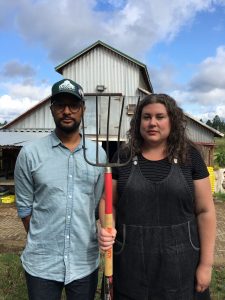In 2019 Zenger Farm was in a challenging organizational transition. There were significant internal conflicts, budget constraints, and a lack of shared vision. As the Board of Directors set out to hire a new leader, the Executive Director role was not an easy one to fill under the current conditions.
Rob joined Zenger Farm in 2015 as a Program Assistant and was working as Operations Director at the time of the ED search. Rob and I knew each other from organizing work with Social Justice Fund NW. When I saw the job posted, I reached out to Rob for insight and we encouraged each other to apply.
As we realized we were both finalists for the position, we saw the merits of having a leadership team that represented the trust of an internal candidate, along with the expertise of a seasoned external leader. We saw the benefit of partnership in the role that seemed like a recipe for rapid burnout. We also saw the advantage of having leaders who represented varied backgrounds and identities.
For these reasons and more, Rob and I pitched to the Board that we come on together as Co-Executive Directors to lead the organization through the difficult and exciting chapter. Over the past 4+ years, we have done just that. As we wrap up our time as Co-EDs we wanted to share some reflections on how the partnership has worked over the past four years.
In gratitude,
Colleen Dixon

What interested you in working in a Co-ED model?
The Co-ED model intrigued us because it promotes collaboration, accountability, and shared leadership. When it started at Zenger Farm’s unique point in its life cycle, it felt like the added support of co-leadership was needed to ensure stability and success. We saw it as an opportunity to bring together different strengths and perspectives as internal and external candidates to lead the organization effectively. We liked how this setup would allow us to leverage our diverse skill sets and experiences to benefit the organization.
Did either of you have experience with co-directorship before joining the Zenger co-director model? How did that support or hinder you in this work?
Colleen had experience with a variety of ‘alternative’ leadership structures, from Co-EDs to three-person leadership teams to staff collectives. Rob had experiences in co-leadership on the board level in serving as Co-Chair for two non-profits, but not at the staff level. The lack of aligned experience didn’t hinder our work; it was a learning opportunity. We embraced it with differing experiences, which allowed us to navigate it successfully.
What did you prioritize when forming a Co-ED model?
We prioritized transparency and open communication from the outset. These elements form the foundation of our co-director model ensured it ran smoothly. Building a strong partnership based on trust and shared values was a top priority. We also focused on fostering an environment that promotes equity, approaching all of our work from this place. It would have served us well if we had prioritized creating a clearer separation of responsibilities and individual job descriptions sooner in the partnership.
What do you both see as the strengths of the Co-ED model?
Collaboration is undoubtedly a highlight. We bring complementary skills to the table, which enhances our problem-solving capabilities. It feels good to have a partner who can step up when the other needs a break, not feeling like the weight of leadership is all on one person. It’s great to have a partner and teammate in a role that can often feel isolated and lonely. It has made it possible to lead through the pandemic and other stressful times while reducing our individual risks of burnout.
What do you both see as the challenges of the Co-ED model?
Balancing responsibilities and aligning our vision effectively can be hard when there are competing or mismatched priorities. Potential hiccups can arise from the need for strong communication to ensure alignment, especially when it comes to day-to-day operations. Challenges often revolve around ensuring that we’re consistently on the same page to avoid duplication or conflicting actions. It can be a challenge to respect the autonomy of our individual leadership styles while still recognizing that individual decision making outcomes have an impact on both leaders.
There is also a challenge at times in aligning on larger strategic decisions when we have different experiences and visions for the work. This can often be easier when there is one leader responsible for these strategies or decisions. There is also the reality that strong personalities are typically drawn to these leadership positions which, at times, can make consensus challenging to reach.
Where is there a division in your roles versus an overlap?
We have intentionally divided our roles based on our strengths and expertise. For instance, Rob’s focus is financial and operational matters, while Colleen focuses on development and communications. However, there is also a significant amount of overlap, particularly when it comes to strategic decision-making, visioning, and staff management. The core leadership functions, such as setting the strategic direction of the organization, are joint efforts in collaboration with the Board of Directors. We both share responsibility for these aspects and contribute our unique perspectives to make well-informed decisions.
How do we navigate questions and issues that may arise in our different experiences and the ways power and authority get projected onto one or the other based on our identities?
We actively address this by fostering open conversations and regular check-ins. When questions or issues arise based on our different experiences or identities, we approach them as opportunities for growth and understanding. We actively listen to each other and consider how to leverage our differences as strengths rather than challenges. It has been interesting to see who may feel more or less comfortable with each of us and how they do or don’t approach us.
We’re committed to maintaining a balance of power and avoiding power imbalances that could result from our different identities. However, some themes we’ve noticed are that Rob often gets asked to participate in external committees or public speaking engagements where there is an interest in racial diversity, putting a bigger burden of those requests on him. Colleen often gets approached for emotional support, listening, venting, and other labor that is often gendered, putting those additional tasks on her. By fostering an environment of mutual respect and awareness of these dynamics, we try to ensure that power is collectively held and decisions are made collaboratively, regardless of our perceived identities.
What has decision-making and visioning looked like?
Throughout our time we created a clear decision making matrix that outlines each person’s role in moving decisions forward. This has been helpful for transparency and clarity on separation duties. Having this document also provides transparency throughout the organization on where power is held and sets expectations on where decision-making is a collaborative effort involving our team members, board, and community stakeholders in discussions.
How do you navigate conflict with your role?
Open and honest communication is our go-to strategy. We actively listen to each other’s perspectives and work towards resolutions that align with our shared vision. Conflict is natural and it is an opportunity for growth. We approach it with a problem-solving mindset and a commitment to maintaining our partnership’s integrity. On occasion we have brought in outside support to help us reach alignment through tough decisions. Our Co-ED model thrives on clear communication, shared vision, and a deep commitment to framing our differences as valuable assets that contribute to each other’s growth and the organization’s strength, rather than as potential obstacles. Holding this at our core has helped us navigate conflict.
How has your Board responded to the Co-ED model, and do you feel supported by them?
Our Board has been supportive and responsive to the Co-ED model. They see the merits and appreciate that it has allowed us to serve as leaders through a variety of challenges that may have burnt out a single leader. The Board respects our autonomy as co-leaders and looks to us for our expertise.
Would you recommend the Co-ED structure?
We believe there is no one right way to structure organizational leadership. It can shift based on the individuals, needs of the organization, cycle of the organization, cultural needs and trends, or a combination of factors. We can see the benefits of a Co-ED structure when an organization is facing a challenging transitional moment or when there are other benefits in having an internal and external person in these positions. No matter the leadership structure, what is most important is a clear leadership vision, delegation of duties, transparent decision-making and the buy-in from board and staff to support the organizational mission.
